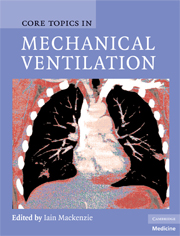Book contents
- Frontmatter
- Contents
- Contributors
- Foreword
- Preface
- Introductory Notes
- 1 Physiology of ventilation and gas exchange
- 2 Assessing the need for ventilatory support
- 3 Oxygen therapy, continuous positive airway pressure and non-invasive ventilation
- 4 Management of the artificial airway
- 5 Modes of mechanical ventilation
- 6 Oxygenation
- 7 Carbon dioxide balance
- 8 Sedation, paralysis and analgesia
- 9 Nutrition in the mechanically ventilated patient
- 10 Mechanical ventilation in asthma and chronic obstructive pulmonary disease
- 11 Mechanical ventilation in patients with blast, burn and chest trauma injuries
- 12 Ventilatory support: extreme solutions
- 13 Heliox in airway obstruction and mechanical ventilation
- 14 Adverse effects and complications of mechanical ventilation
- 15 Mechanical ventilation for transport
- 16 Special considerations in infants and children
- 17 Tracheostomy
- 18 Weaning, extubation and de-cannulation
- 19 Long-term ventilatory support
- 20 The history of mechanical ventilation
- Glossary
- Index
12 - Ventilatory support: extreme solutions
Published online by Cambridge University Press: 14 October 2009
- Frontmatter
- Contents
- Contributors
- Foreword
- Preface
- Introductory Notes
- 1 Physiology of ventilation and gas exchange
- 2 Assessing the need for ventilatory support
- 3 Oxygen therapy, continuous positive airway pressure and non-invasive ventilation
- 4 Management of the artificial airway
- 5 Modes of mechanical ventilation
- 6 Oxygenation
- 7 Carbon dioxide balance
- 8 Sedation, paralysis and analgesia
- 9 Nutrition in the mechanically ventilated patient
- 10 Mechanical ventilation in asthma and chronic obstructive pulmonary disease
- 11 Mechanical ventilation in patients with blast, burn and chest trauma injuries
- 12 Ventilatory support: extreme solutions
- 13 Heliox in airway obstruction and mechanical ventilation
- 14 Adverse effects and complications of mechanical ventilation
- 15 Mechanical ventilation for transport
- 16 Special considerations in infants and children
- 17 Tracheostomy
- 18 Weaning, extubation and de-cannulation
- 19 Long-term ventilatory support
- 20 The history of mechanical ventilation
- Glossary
- Index
Summary
Introduction
One of the extreme solutions for the management of ventilatory failure is to replace the lungs altogether, either by transplantation or by the use of machines. Once the transplant has been completed, the means used to support the new lungs are little different from those used for any other patient. This statement will be a surprise to some because the transplanted lung has necessarily suffered many injuries during transplantation: in practical terms, the question of how best to ventilate a sick lung encompasses the field of lung transplantation. However, transplantation can only be offered to a few patients with the highest chance of survival in order to avoid the waste of precious resources. In the context of severe respiratory failure, other solutions are therefore necessary to provide ventilatory support, either as a bridge to recovery or transplantation, or as long-term support in an increasingly elderly Western population. These solutions are based on various mechanical means that take over some of the lung functions. Despite great advances in technology, these new methods are at present only temporary, intensive and laborious in their implementation and are usually accompanied by a high morbidity and mortality.
This chapter will review some of the key clinical questions concerning the ventilation of the lung transplant recipient and mechanical support of the failing lung.
- Type
- Chapter
- Information
- Core Topics in Mechanical Ventilation , pp. 222 - 229Publisher: Cambridge University PressPrint publication year: 2008

